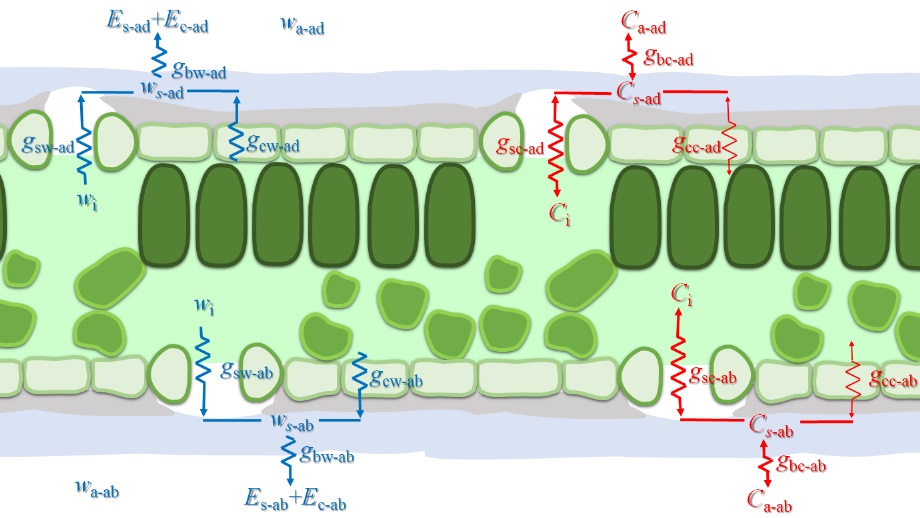PS Webinar Series: PhD Exit Seminar - Dynamics of water and carbon dioxide gas-exchange through the adaxial and abaxial surfaces of leaves
Accurate estimation of gas exchange parameters has always been a fundamental aim of plant physiologists; from the more general assumptions and calculations presented by Moss and Rawlins (1963) up to the widely used model introduced by von Caemmerer and Farquhar (1981).
Speakers
Event series
Content navigation
Description

Abstract - Accurate estimation of gas exchange parameters has always been a fundamental aim of plant physiologists; from the more general assumptions and calculations presented by Moss and Rawlins (1963) up to the widely used model introduced by von Caemmerer and Farquhar (1981). Plant physiologists are always aiming for more precise and reliable measurements to interpret physiological traits or genetic variations. In this constant demand for increased precision, the previously trivial assumptions made in the calculations become important sources of error as greater precision is sought.
I examined H2O vapour and CO2 pathways and dynamics in leaves during gas exchange, focusing on three main aspects of it: (1) cuticular conductance to H2O and CO2; (2) adaxial and abaxial leaf gas exchange; and (3) leaf internal CO2 concentration. The objective was to determine the impact of these factors on the calculation of gas exchange parameters, generating a mathematical theory to quantify them in more detail, aiming for a theoretical approach with practical implications, rather than a solely descriptive outcome.
During my thesis I used data from gas exchange measurements made using various devices, combined in different experimental setups, to obtain a quantitative analysis of leaf gas exchange. Experiments were performed on a variety of plant species to generate a robust dataset to support a theoretical approach and validate the proposed method. As for many studies in plant physiology, the internal CO2 concentration is a crucial direct or indirect factor for interpreting the results; so I devoted special attention to the estimation of internal CO2 concentration. My theoretical approach resulted in a more accurate calculation of leaf gas exchange values and increased the exactitude of the estimation of internal leaf CO2 concentration.
Abbreviations for the presentation, use this LINK
Biography - PhD student in Farquhar Group
Who you are, a little about yourself
I studied Agronomic Engineering at the University of Chile and a Masters in Soil and Water management also at the University of Chile. I worked in the winery sector for several years, focusing my work on water management mostly.
A bit about your research and why it is important
My research is focused on improving our understanding of leaf gas exchange dynamics and the calculations of gas exchange parameters, through generating mathematical theory and models, aiming for a theoretical approach with practical implications.
What drives you to research plant science?
I have always been amazed by the concept that plants (photosynthetic organisms) are the main source of energy for all the organisms in the earth. That is why I enjoying studying the interaction between water and the soil-plant-atmosphere continuum that allows terrestrial plants to succeed in non-aquatic environments.
Your experience with RSB over the past few years
I have met a lot of great people during the years I have been in RSB. RSB has a very supporting and friendly environment, which has created a very enjoyable experience during my PhD.
Location
Please note: this seminar will be held in the Slatyer Rm and via Zoom, details are included below.
Slatyer Rm, Rm N2011, Level 2, RN Robertson Building (46)
Hi there,
You are invited to a Zoom webinar.
When: Dec 18, 2020 12:00 PM Canberra, Melbourne, Sydney
Topic: Diego's Webinar
Please click the link below to join the webinar:
https://anu.zoom.us/j/82968546025?pwd=OUtqOU43OXdIRURvRjBCeEJVNHIrUT09
Webinar ID: 829 6854 6025
Passcode: 543099
Or iPhone one-tap :
Australia: +61280156011,,82968546025#,,,,,,0#,,543099# or +61370182005,,82968546025#,,,,,,0#,,543099#
Or Telephone:
Dial(for higher quality, dial a number based on your current location):
Australia: +61 2 8015 6011 or +61 3 7018 2005 or +61 7 3185 3730 or +61 8 6119 3900 or +61 8 7150 1149
International numbers available: https://anu.zoom.us/u/kdogUbHsuy
Or an H.323/SIP room system:
H.323: zoom.aarnet.edu.au
Meeting ID: 829 6854 6025
Passcode: 543099
SIP: 82968546025@zoom.aarnet.edu.au
Passcode: 543099




